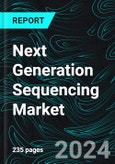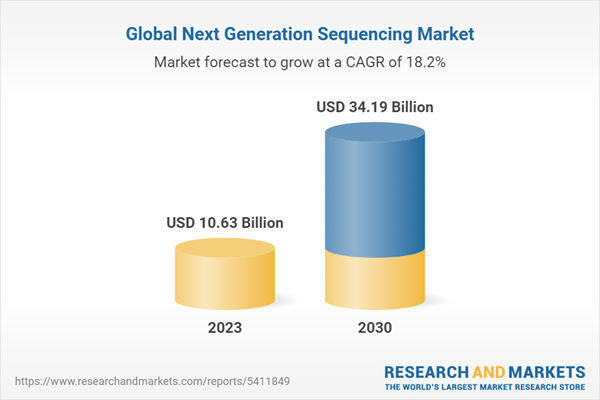Global Next Generation Sequencing (NGS) Market is anticipated to experience a CAGR of 18.16% from 2024 to 2030
The growing adoption of Next-Generation Sequencing (NGS) in scientific prognosis propels the worldwide NGS market expansion. NGS's capacity to offer comprehensive genetic statistics has unexpectedly improved its position in diagnosing various illnesses and assisting in personalized remedy decisions. The growing demand for precision medicinal drugs and improvements in genomic research expand NGS applications, fostering market growth. As NGS becomes necessary for medical workflows, its full use in diagnostics contributes drastically to the non-stop enlargement of the global market.The market is growing because many companies are replacing outdated technology like microarrays with NGS, which gives superior accuracy, better throughput, and cost-effectiveness compared to standard methods. In 2022, a piece of writing published by Elsevier stated that NGS is advanced compared to microarrays in detecting DNA and appears to have other genomic obligations. As more and more businesses transfer from older technologies to NGS systems for genomic evaluation, the market is experiencing full-size growth. This shift highlights the vital position of NGS in advancing research, diagnostics, and personalized medicinal drugs, driving the continuous development of the next-era sequencing market.
North America and Europe are witnessing fast scientific trends in NGS methodologies for oncology and infectious disease applications. As researchers and healthcare experts seek complete solutions, NGS offerings, including sequencing and data interpretation, have become important. The advent of NGS panels, designed for focused sequencing of particular genomic regions, has revolutionized genetic analysis, imparting cost-effective and efficient solutions for various applications. Advancements in NGS technology and growing cognizance across various sectors make certain a promising future for genomics and precision medicine. Hence, the global next-generation sequencing (NGS) market was US$ 10.63 Billion in 2023.
Reagents and consumables sector accounted for a significant portion of the global next-generation sequencing market
By products, the global next-generation sequencing market is fragmented into Instruments, Reagents & Consumables, and Services. The reagents and consumables phase held one of the most significant shares in the global next-generation sequencing market. This, in particular, is attributed to the recurrent utilization and high demand for reagents and consumables in NGS's commercial and research applications. These consumables encompass sample preparation kits as well as kits for target enrichment. The adoption of NGS reagents and consumables has expanded as most pharmaceutical agencies and research institutes are utilizing NGS for several diagnostic programs and cancer studies.Diagnostic application is one of the most critical segments in the global next-generation sequencing market
By application, the global next-generation sequencing market is segmented into Diagnostics, Agriculture and Animal Research, Drug Discovery, Personalized Medicine and Genetic Screening, and Others. Diagnostic applications are pivotal in the global Next-Generation Sequencing (NGS) market. This is due to their direct effect on healthcare. NGS's capability to research genetic versions enables precise disease prognosis, diagnosis, and personalized remedy selection. This section addresses important wishes in oncology, uncommon diseases, infectious illnesses, and prenatal screening, driving market increase. As healthcare structures prioritize precision medicine and genomic-pushed tactics, diagnostic applications become a cornerstone, contributing notably to the prominence and expansion of the global NGS market.Sequencing by synthesis is one of the top technologies in the global market for next-generation sequencing
By technology, the global next-generation sequencing market is categorized into Sequencing by Synthesis, Ion Semiconductor Sequencing, Single-Molecule Read Time Sequencing, Nanopore Sequencing, and Others. Sequencing by synthesis (SBS) is one of the most famous technologies in the global Next-Generation Sequencing (NGS) market. This technology permits immediate and correct sequencing by constructing complementary DNA strands step by step. Its significant use is pushed through its capability to utilize vast quantities of data, produce low mistake rates, and be cost-effective, making it ideal for various programs in studies, diagnostics, and customized medicine. As the desire for big-scale genomic evaluation continues to develop, SBS will remain an important technology, expanding the worldwide NGS market in the coming years.Academic and clinical research centers are expected to be one of the fastest-growing segments in the global market
The end-users classify the global next-generation sequencing market into Academic and Clinical Research Centers, Pharmaceutical and Biotechnology Companies, Hospitals and Clinics, and Others. The academic and clinical research facilities segment is anticipated to be one of the quickest-growing segments within the market. This is due to the increasing use of next-generation sequencing (NGS) in cancer research. This technology enables the identification of new cancer-related genes, the examination of tumor heterogeneity, and the detection of alterations contributing to tumorigenesis. Also, providing scientific studies through market entities is predicted to offer ample opportunities for enhancing and detecting goals in this area.United States will lead the global Next-Generation Sequencing (NGS) market
By countries, the global next-generation sequencing market is organized into North America (United States, Canada), Europe, France, Germany, Italy, Spain, United Kingdom, Belgium, Netherlands, Turkey), Asia Pacific (China, Japan, India, Australia, South Korea, Thailand, Malaysia, Indonesia, New Zealand), Latin America (Brazil, Mexico, Argentina), Middle East & Africa (South Africa, Saudi Arabia, United Arab Emirates). The global Next-Generation Sequencing (NGS) market is expected to be led by the United States. This is due to the country's advanced healthcare infrastructure, robust research capabilities, and significant investments in genomics. The US has created a favorable environment for NGS adoption, supported by extensive funding, a solid regulatory framework, and a thriving biotechnology industry. Predicine, Inc. announced in September 2022 regarding the PredicineCARETMcfDNA Assay. This is an NGS assay used for tumor mutation profiling in cfDNA. The cfDNA is isolated from liquid biopsy samples taken from cancer patients. The US FDA has granted this assay breakthrough device designation. This ensures its prominent role and leadership in the global NGS market.Key Players
Illumina, Thermo Fisher Scientific, Pacific Biosciences, QIAGEN N.V., Roche, Bio-Rad Laboratories, Inc., Takara Bio Inc., Hamilton Company, Geneious, and BioMérieux SA are the major companies in the global next-generation sequencing (NGS) market.In December 2023 - Illumina inscribed a memorandum of understanding with the African Society for Laboratory Medicine to improve access to genomics within the African region to combat infectious diseases.
In March 2023 - The company SOPHiA GENETICS partnered with Qiagen to use QIAseq reagent technology with the DDM platform to improve tumor analysis using next-generation sequencing (NGS).
The report titled “Global Next-Generation Sequencing (NGS) Market By Products (Instruments, Reagents & Consumables, and Services), Application (Diagnostics, Agriculture and Animal Research, Drug Discovery, Personalized Medicine and Genetic Screening, and Others), Technology (Sequencing by Synthesis, Ion Semiconductor Sequencing, Single-Molecule Read Time Sequencing, Nanopore Sequencing, and Others), End-Users(Academic and Clinical Research Centers, Pharmaceutical and Biotechnology Companies, Hospitals and Clinics, and Others),Countries (North America (United States, Canada), Europe, France, Germany, Italy, Spain, United Kingdom, Belgium, Netherlands, Turkey), Asia Pacific (China, Japan, India, South Korea, Thailand, Malaysia, Indonesia, Australia, New Zealand), Latin America (Brazil, Mexico, Argentina), Middle East & Africa (Saudi Arabia, United Arab Emirates, South Africa)) Company Analysis (Illumina, Thermo Fisher Scientific, Pacific Biosciences, QIAGEN N.V., Roche, Bio-Rad Laboratories, Inc., Takara Bio Inc., Hamilton Company, Geneious, and BioMérieux SA)” provides a complete study of the Global Next-Generation Sequencing (NGS) Industry.
Product - Global Next-Generation Sequencing (NGS) Market breakup in 3 viewpoints:
1. Instruments2. Reagents & Consumables
3. Services
Application - Global Next-Generation Sequencing (NGS) Market breakup in 5 viewpoints:
1. Diagnostics2. Agriculture and Animal Research
3. Drug Discovery
4. Personalized Medicine and Genetic Screening
5. Others
Technology - Global Next-Generation Sequencing (NGS)Market breakup in 5 viewpoints:
1. Sequencing by Synthesis2. Ion Semiconductor Sequencing
3. Single-Molecule Read Time Sequencing
4. Nanopore Sequencing
5. Others
End-Users - Global Next-Generation Sequencing (NGS) Market breakup in 4 viewpoints:
1. Academic and Clinical Research Centers2. Pharmaceutical and Biotechnology Companies
3. Hospitals and Clinics
4. Others
Countries - Global Next-Generation Sequencing (NGS) Market of 25 Countries:
1 North America1.1 United States
1.2 Canada
2 Europe
2.1 France
2.2 Germany
2.3 Italy
2.4 Spain
2.5 United Kingdom
2.6 Belgium
2.7 Netherlands
2.8 Turkey
3 Asia Pacific
3.1 China
3.2 Japan
3.3 India
3.4 South Korea
3.5 Thailand
3.6 Malaysia
3.7 Indonesia
3.8 Australia
3.9 New Zealand
4 Latin America
4.1 Brazil
4.2 Mexico
4.3 Argentina
5 Middle East & Africa
5.1 Saudi Arabia
5.2 United Arab Emirates
5.3 South Africa
All the Key players have been covered from 3 Viewpoints:
- Overview
- Recent Development
- Revenue Analysis
Company Analysis:
1. Illumina2. Thermo Fisher Scientific
3. Pacific Biosciences
4. QIAGEN N.V.
5. Roche
6. Bio-Rad Laboratories, Inc.
7. Takara Bio Inc.
8. Hamilton Company
9. Geneious
10. BioMérieux SA
Table of Contents
Companies Mentioned
- Illumina
- Thermo Fisher Scientific
- Pacific Biosciences
- QIAGEN N.V.
- Roche
- Bio-Rad Laboratories, Inc.
- Takara Bio Inc.
- Hamilton Company
- Geneious
- BioMérieux SA
Methodology
In this report, for analyzing the future trends for the studied market during the forecast period, the publisher has incorporated rigorous statistical and econometric methods, further scrutinized by secondary, primary sources and by in-house experts, supported through their extensive data intelligence repository. The market is studied holistically from both demand and supply-side perspectives. This is carried out to analyze both end-user and producer behavior patterns, in the review period, which affects price, demand and consumption trends. As the study demands to analyze the long-term nature of the market, the identification of factors influencing the market is based on the fundamentality of the study market.
Through secondary and primary researches, which largely include interviews with industry participants, reliable statistics, and regional intelligence, are identified and are transformed to quantitative data through data extraction, and further applied for inferential purposes. The publisher's in-house industry experts play an instrumental role in designing analytic tools and models, tailored to the requirements of a particular industry segment. These analytical tools and models sanitize the data & statistics and enhance the accuracy of their recommendations and advice.
Primary Research
The primary purpose of this phase is to extract qualitative information regarding the market from the key industry leaders. The primary research efforts include reaching out to participants through mail, tele-conversations, referrals, professional networks, and face-to-face interactions. The publisher also established professional corporate relations with various companies that allow us greater flexibility for reaching out to industry participants and commentators for interviews and discussions, fulfilling the following functions:
- Validates and improves the data quality and strengthens research proceeds
- Further develop the analyst team’s market understanding and expertise
- Supplies authentic information about market size, share, growth, and forecast
The researcher's primary research interview and discussion panels are typically composed of the most experienced industry members. These participants include, however, are not limited to:
- Chief executives and VPs of leading corporations specific to the industry
- Product and sales managers or country heads; channel partners and top level distributors; banking, investment, and valuation experts
- Key opinion leaders (KOLs)
Secondary Research
The publisher refers to a broad array of industry sources for their secondary research, which typically includes, however, is not limited to:
- Company SEC filings, annual reports, company websites, broker & financial reports, and investor presentations for competitive scenario and shape of the industry
- Patent and regulatory databases for understanding of technical & legal developments
- Scientific and technical writings for product information and related preemptions
- Regional government and statistical databases for macro analysis
- Authentic new articles, webcasts, and other related releases for market evaluation
- Internal and external proprietary databases, key market indicators, and relevant press releases for market estimates and forecasts

LOADING...
Table Information
| Report Attribute | Details |
|---|---|
| No. of Pages | 235 |
| Published | February 2024 |
| Forecast Period | 2023 - 2030 |
| Estimated Market Value ( USD | $ 10.63 Billion |
| Forecasted Market Value ( USD | $ 34.19 Billion |
| Compound Annual Growth Rate | 18.1% |
| Regions Covered | Global |
| No. of Companies Mentioned | 10 |









